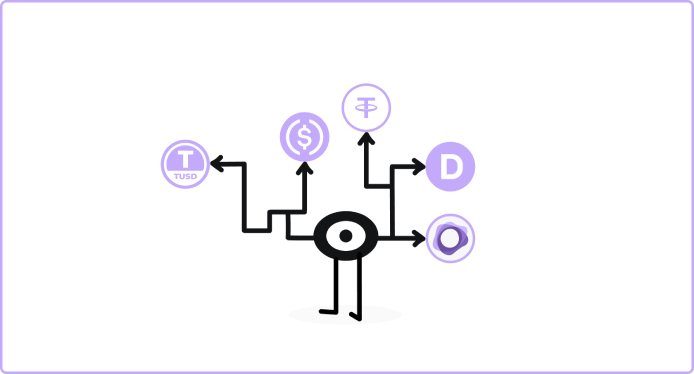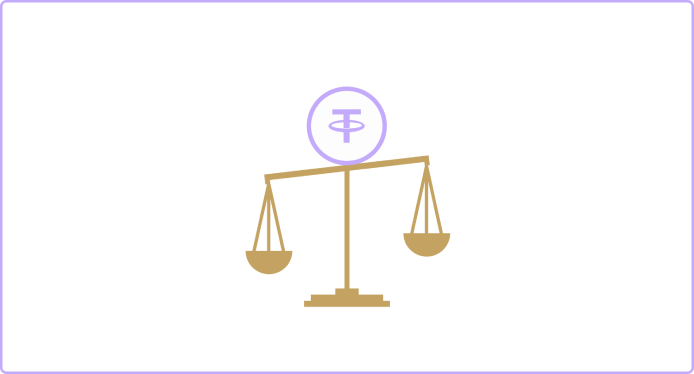
What is a stablecoin in cryptocurrency?
Stablecoin is a general name for cryptocurrencies whose exchange rate is pegged to real world currencies or to exchange commodities such as gold or oil.
One of the characteristics of cryptocurrency is high volatility (an indicator of fluctuations in the market price and income over a certain period of time). For example, the level of volatility of Bitcoin exceeds even gold. To stabilize the exchange rate, they resort to the option of tying cryptocurrency to ordinary currency. The disadvantage of such a method is that the level of trust in a centralized exchange mechanism required to maintain the exchange rate contradicts the nature of cryptocurrency, which is decentralized.
Stablecoins were created with the aim of bridging cryptocurrency and conventional finance, to combine trust and stability with the affordability and reliability of crypto.
When did stablecoin appear?
In July 2014, the Tether cryptocurrency was created, it is the first stablecoin in the history of cryptocurrencies. The creators were Reeve Collins, Brock Pierce and Craig Sellars. Tether USD runs on multiple blockchains.
Types of stablecoins
Stablecoins can be classified based on their core mechanisms, peg mechanisms and governance structures:
- Centralized stablecoins. These stablecoin assets are issued and managed by a central authority or company that holds the reserves and maintains the peg. While centralized stablecoins offer stability and liquidity, they also introduce counterparty risk and depend on the honesty of the issuer.
- Decentralized stablecoins. In contrast, decentralized ones operate on blockchain networks without a central authority. They rely on smart contracts to manage reserves, collateral and stability mechanisms, providing greater transparency and resistance to censorship. However, they may face liquidity and scalability issues.
- Hybrid stablecoins. Some stablecoins combine elements of both centralized and decentralized models to leverage the strengths of each approach while mitigating their weaknesses.

Cryptocurrency: How do stablecoins work?
Stablecoins are backed by stable assets, as mentioned above: gold, silver, oil, dollar or euro, so they are more stable. Thanks to this, they hold their value. Stablecoins play an important role in the cryptocurrency mechanism and are an integral part of it. They keep the crypto stable, make transactions and investments much easier. Stablecoins are backed by other currencies and assets, so they are key in the international trade market, the DeFi sector, and have wide application in everyday life.
Fiat-backed stablecoins are backed by fiat currency reserves, such as the US dollar, held by a trusted third party. Each token issued is backed by an equivalent amount of fiat currency held in a reserve that ensures a 1:1 peg. Examples include Tether (USDT), USD Coin (USDC), and TrueUSD (TUSD).
Instead of fiat currency, crypto-backed stablecoins are backed by reserves of other cryptocurrencies. Smart contracts manage the collateral, ensuring that the value of the underlying assets exceeds the value of the issued stablecoins. MakerDAO’s Dai, backed by Ethereum (ETH), is a prime example.
Also, stablecoins use algorithmic mechanisms to maintain stability without relying on collateral reserves. Algorithms automatically adjust the stablecoin’s money supply in response to changes in demand, aiming to keep the price stable. Basis (formerly known as Basecoin) attempted this approach, but ran into regulatory issues and eventually went out of business.

Stablecoin regulation
Today, at least 45 central banks of the world have implemented the launch of a national stablecoin. And they tie it to national fiat funds. Therefore, the countries of the world are wondering about the regulation of stablecoin. Each country introduces its own mechanism for regulating cryptocurrency. A stablecoin tied to a fiat currency is governed by the laws and regulations that govern traditional currency. With others, it is more difficult, they have not yet created a single algorithm that would regulate cryptocurrency. In Ukraine, in 2022, the Law “On Virtual Assets” was adopted to regulate turnover, including stablecoin. But the necessary amendments to the Tax Code of Ukraine are still at the draft law stage, the legislative acts of the National Bank of Ukraine are at the draft stage, therefore the Law “On Virtual Assets” has not entered into force.

Advantages and disadvantages
Among the main advantages it is worth identifying:
- Stability. The main attraction of stablecoins is their stability. Pegged to a stable asset, such as a fiat currency, commodity, or algorithmic engine, cryptocurrency stablecoins seek to maintain a constant value by providing users with a reliable store of value and medium of exchange;
- Transactions without borders. Thanks to the use of blockchain technology, stablecoins provide seamless international transactions with minimal fees and fast settlements. This availability of cryptocurrency holds enormous potential for remittances, international trade, and financial inclusion, especially in regions with unstable local currencies or limited access to traditional banking services;
- Transparency and security. Blockchain-based stablecoins offer transparency through immutable transaction records, giving users greater confidence in the integrity of the system. In addition, the decentralized nature of many stablecoin projects reduces the risk of isolated failures and potential malicious attacks, increasing security and resilience;
- Financial innovations. Stablecoins serve as a catalyst for financial innovation by providing programmable money through smart contracts. This capability enables a multitude of applications, including decentralized finance (DeFi) protocols, automated lending and borrowing platforms, and tokenized assets, opening up new ways to participate in the economy and create value;
- Risk hedging. Investors and traders use stablecoins as a risk management tool to insure against market volatility. During periods of uncertainty or market downturns, stablecoins offer a safe haven, allowing market participants to preserve capital and reduce potential losses without leaving the cryptocurrency ecosystem entirely.
Disadvantages of stablecoins:
- Regulatory uncertainty. The regulatory landscape surrounding stablecoins remains murky as authorities struggle to define their classification and oversight framework. Uncertainty about compliance requirements and potential regulatory crackdowns pose significant challenges for stablecoin issuers, exchanges, and users, potentially holding back innovation and adoption;
- Systemic risks. The interconnectedness of stablecoins with the broader financial system creates systemic risks, especially in the event of a widespread market shock or liquidity crisis. Depletion of stablecoin reserves, regulatory interventions, or technological vulnerabilities could trigger cascading effects, leading to market contagion and instability.

Examples of stablecoins
Stablecoins are cryptocurrencies designed to minimize price fluctuations, often by tying their value to stable assets such as fiat currency, commodities, or other cryptocurrencies. Here are some of the most famous and popular stablecoins:
- Tether (USDT): Tether is one of the oldest and most widely used stablecoins. It claims to be backed by a 1:1 US dollar held in reserve, although there has been some controversy and scrutiny over its reserves.
- USD Coin (USDC): USDC is a stablecoin pegged to the US dollar that is regulated and issued by regulated financial institutions. Thanks to regular audits, it is considered one of the most transparent stablecoins.
- DAI: DAI is a decentralized stablecoin issued on the Ethereum blockchain. It is backed by collateral like other cryptocurrencies, and its value is stabilized by an autonomous smart contract system.
- TrueUSD (TUSD): TrueUSD is a stablecoin backed 1:1 by US dollars held in escrow accounts. It is also regularly reviewed to ensure transparency and stability.
- Paxos Standard (PAX): PAX is another stablecoin pegged to the US dollar and regulated by the New York State Department of Financial Services. It is backed 1:1 by US dollars held in FDIC-insured banks.
These stablecoins are among the most widely used and recognized cryptocurrencies in the market, each with its own characteristics, regulatory compliance and methods of maintaining stability.
 Support
Support 









